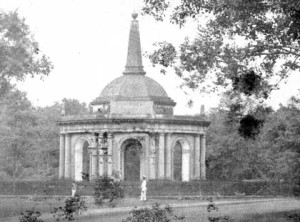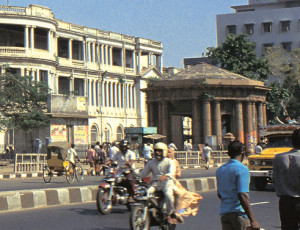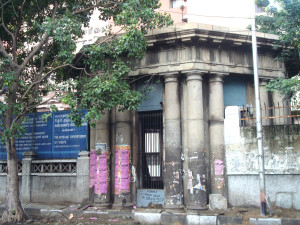Registered with the Registrar of Newspapers for India under R.N.I 53640/91
Vol. XXIX No. 13, October 16-31, 2019
Lost Landmarks of Chennai
The Hyde Park of Madras
Cenotaph remains a name in the Teynampet area, with an eponymous road leading off Anna Salai/Mount Road towards Kotturpuram and beyond. As is well known, the name is traced to the vast monument that was erected on the spot in memory of Lord Cornwallis, Governor General and Commander-in-Chief of India from 1786 to 1793 and once again Governor General of India in 1805.
The circumstances leading to the commissioning of a statue of the Governor General and the construction of a cenotaph are dealt with in great detail in the series titled Know Fort St George (MM XXV Vol. Nos. 1-24, April 16th 2015-April 1st 2016). In brief, the British in Madras were living in mortal fear of Hyder Ali and his son Tipu Sultan and it was Cornwallis who in the third Anglo Mysore war showed that the latter was fallible after all. The Tiger of Mysore had to accept crippling war damages – more than half of his territory was distributed among allies and two of his sons were taken as hostages. In gratitude for what Cornwallis had done, the British in Madras commissioned Thomas Banks in England to sculpt a statue which was completed in 1800 and arrived here to be erected behind the present-day Assembly building, Fort St George, under a cupola. Cornwallis during his second and very brief tenure as Governor General saw it in person at this site.
In 1805, with Cornwallis dead, the British in Madras decided on a much larger monument – a cenotaph no less, under which they planned to position the statue in the Fort. The structure was soon completed at Teynampet but for various reasons (see MM, June 16, 2015) the statue was not moved there. It was only in the early 1900s by which time the cenotaph had itself been moved to First Line Beach that the shift was made. The statue did not survive for long under the cenotaph, being soon shunted to the Connemara Library and from there, after Independence, to the Fort Museum. The cenotaph remains outside the Chennai Collectorate, once Bentinck’s Building and now a drab structure named after the labour leader M Singaravelar. It is mostly unoccupied but does serve as a urinal at times. Its longevity is nevertheless a matter to ponder over – it has survived a shift from Teynampet and later the complete demolition of Bentinck’s Building as well.
But several questions remain – who designed the cenotaph and what was it like when it stood in its original site at Teynampet? Answers to these are now happily found in William Taylor’s Madrasiana (published 1868). The following account is largely from this source with some quotes from others who are independently acknowledged in this article.
On November 5, 1805, a public meeting called by John Oakes, Sheriff of Madras, was held at the Exchange, now the Fort Museum, Fort St George, to come up with ideas on a suitable memorial for the late Governor General. A committee was formed and some of the prominent names included, apart from Oakes, Benjamin Roebuck, Basil Cochrane and Thomas Parry. It was unanimously agreed that a cenotaph be erected.


Our Old is the Cenotaph, as it stood in all its (hideous) glory at the intersection of Cenotaph and Mount Roads in the 19th Century. Our Not so New from the 1980s is the same structure with magnificient Bentinck’s Building forming a fitting backdrop. Our New by R. Shantaram shows the structure as it is now – with posters on the pillars and a general air of decrepitude.

The design was by John Gantz (1772-1853), who was Chief Draughtsman of the East India Company, Madras. Vyasarpadi was where he lived and a Gantz Road there (now Ambedkar Salai) commemorated him for long. He and his son Justinian were lithographers as well and executed several works chiefly comprising the sights and scenes of the city. Justinian also went on to establish the Madras Times, one of the city’s newspapers, in 1859. The committee closely supervised the execution and in 1810 also approved a long inscription commemorating Lord Cornwallis to be placed inside the cenotaph. This was entirely in Latin, written by C. Marsh, a resident of Madras. The Literary Panorama and National Register, a publication from England questioned as to whether the natives would ever understand a word of what was written but it appears that this query did not have any effect.
Maria Graham, who came here early in the 1810s noted that “it is the fashion for all the gentlemen and ladies to repair in their gayest equipages to the Mount road and after driving furiously along they loiter round and round the cenotaph for an hour, partly for exercise and partly for the opportunity of flirting and displaying their fine clothes; after which they go home, to meet again every day in the year.” The cenotaph, noted Maria, “cost an immense sum of money, but is not remarkable for good taste.” Besides this account, there are plenty of others that repeat the same fact – of the British in Madras going around it of an evening and how it soon came to replace Cupids Bow by the beach (now occupied by the War Memorial) as the spot to be seen at.
By the time Taylor wrote his Madrasiana the space around the monument had clearly undergone some changes. But his is a word picture that is worth reproducing here in full –
“The monument was always as it now is; but (as may be judged by the wide sweep around) the interior closed by an iron railing was originally much more spacious. It took an oval form; and the enclosed space was laid out with paths and planted with a few evergreens; never properly cultivated or care for. The interior of the building had merely benches and chairs; but Romance declares that many a man there wooed his future mate; and hints that ghosts, and night apparitions were not wanting – fabulous, without doubt. The iron railings of the outer circuit were all spear-headed.”
Here Taylor hints that the railings had all gone by the time he saw the cenotaph and that there was an inferior replacement in place – “Who sold all that old iron, and set up a paltry substitute, we do not happen to know.”
The cenotaph itself was clearly going to seed by then for he also writes, “Perhaps it now might be scarcely credited that this place was once the Hyde Park of Madras, and the road thence eastward its Piccadily.”
Taylor then goes on to describe the long line carriages making their way home, each one’s path lit by two grooms bearing two lanterns each. These men evidently waited near Blacker’s Gardens (now Congress Grounds, see MM, June 16, 2019) and from there a brisk canter meant the Horticultural Society gardens. Here, as people went to their respective homes the lights would divide and branch off, “as numerous as fire-flies, only much larger; and, like them, moving in all directions; a kaleidoscope of lights constantly changing figure.” Who can imagine all this on Anna Salai and Cathedral Road today?


This is the first and opportune moment to read this publication .A worthy journal. I moved out of Madras in1961. Have got reunited to my past life , and place of birth .Just am happy to keep in touch. Regards